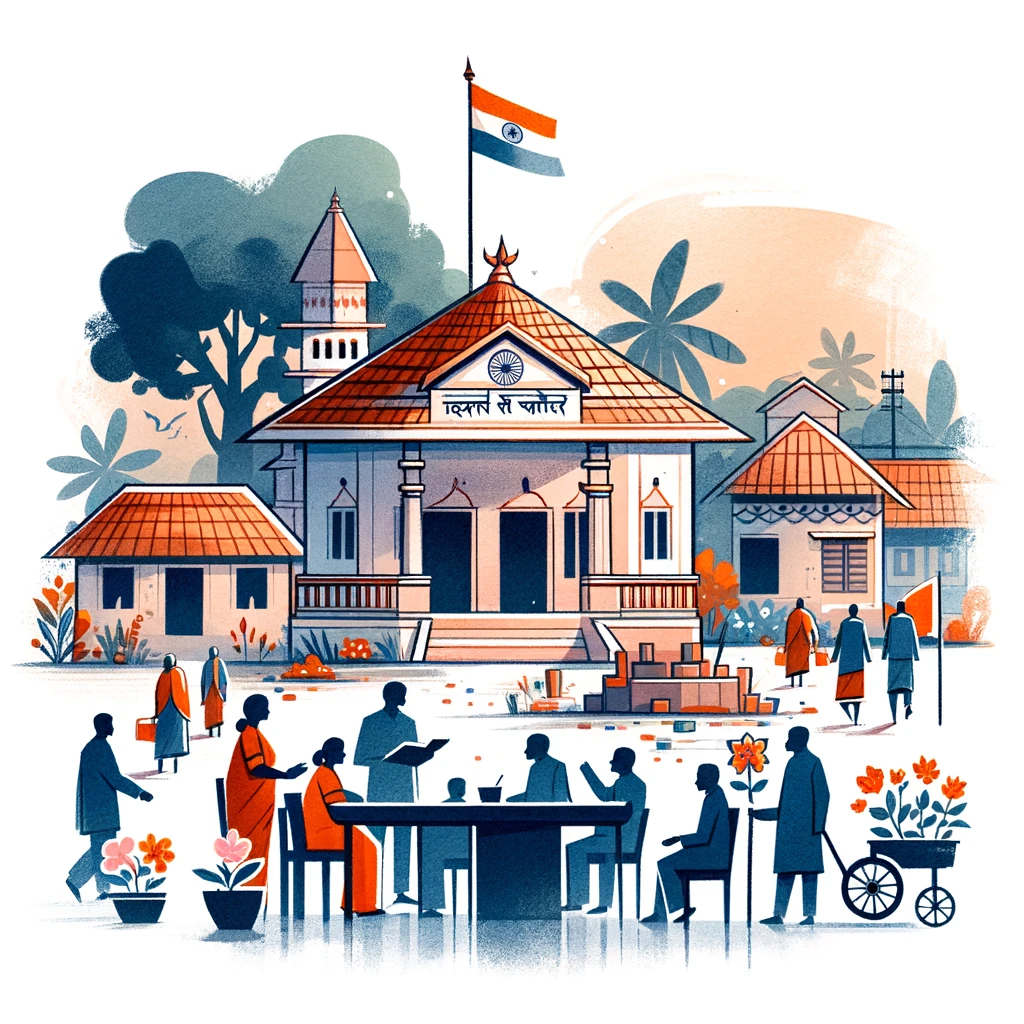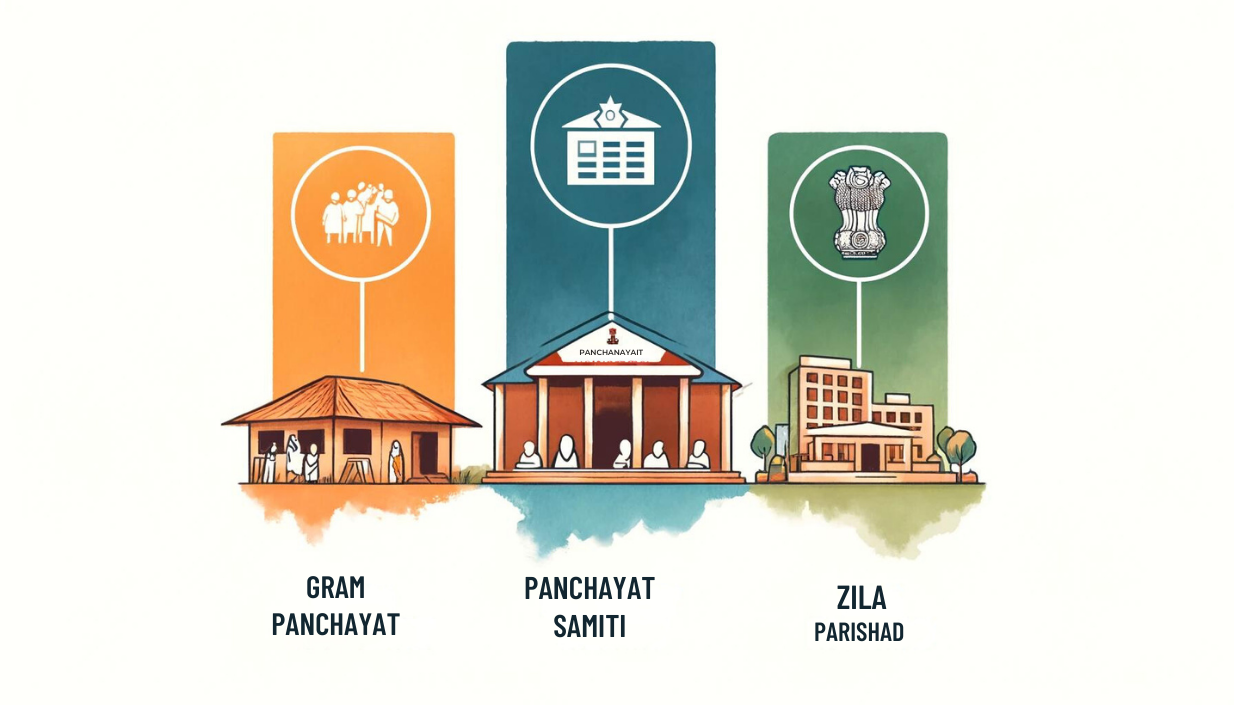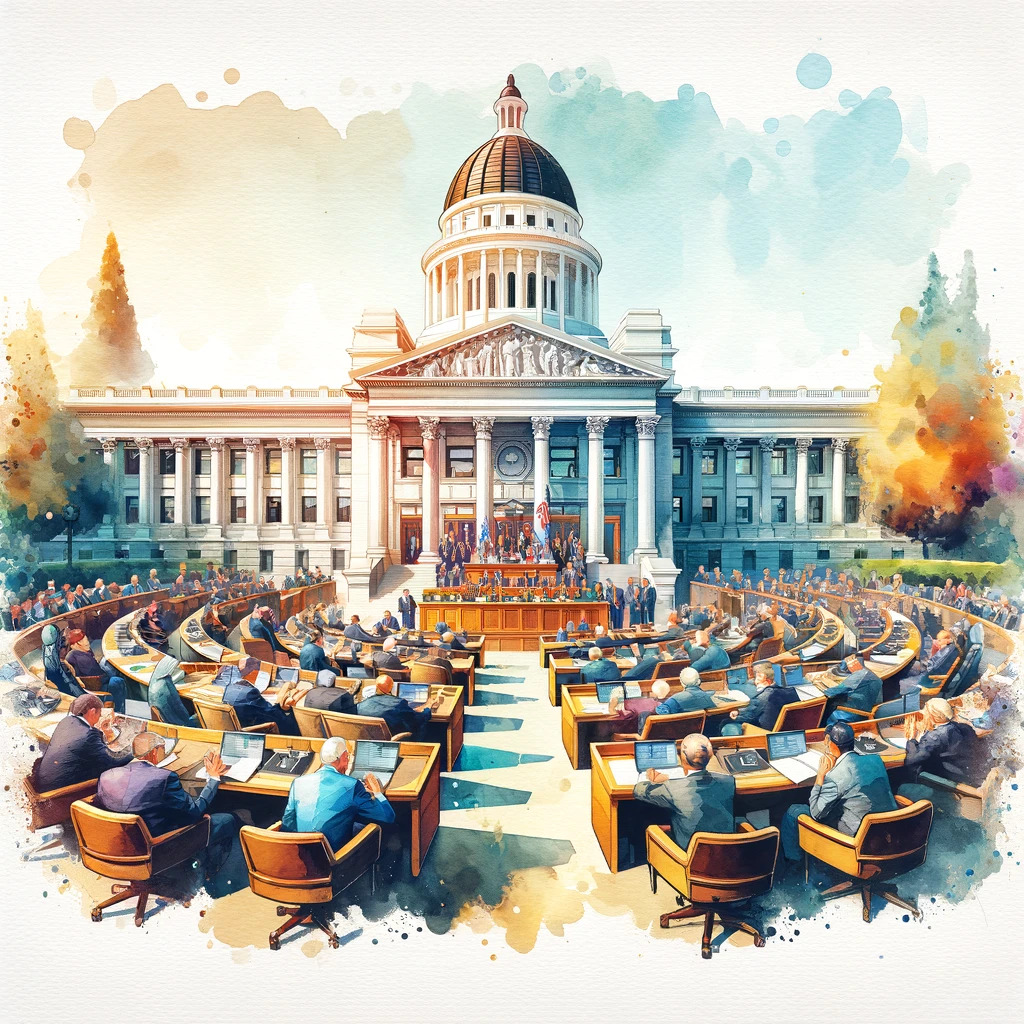Panchayati Raj is a form of government in which each village or a group of villages is managed by local self-government bodies. It thus privileges a bottom-up approach to governance and seeks to bring democracy as close as possible to the grassroots level. The gram panchayats at village levels, panchayat samitis at block levels, and district councils at the district levels. The basic goals of Panchayati Raj include economic development, social justice, and grassroots democracy.
- India’s experience with the Panchayati Raj system has not been pleasant, as constant interference by the state governments in their functioning has defeated the objective of this model.
- The double objectives of Panchayati Raj are democratic and economic. The Villagers can strive for their own prosperity and concentrate on solving what they perceive to be the most vital problems, since decisions that are taken at the local level can be effectively carried out by whomsoever they directly concern.

Historical Background and Evolution of Panchayati Raj in India
The concept of local self-governance is not new to India. The Panchayati Raj system has its roots in ancient India, where village councils, or panchayats, were traditional institutions of local governance.
Historical Evolution
- Ancient and Medieval Periods: These existed in the form of village panchayats, exercising traditionally imperative functions related to local administration, dispute resolution, and handling community resources.
- British Period: While the colonial administration did establish some forms of local self-government, its principal intention was essentially revenue collection, not political empowerment of the local communities.
- Post-Independence Period: There was a need felt for an organized Panchayati Raj system in order to promote rural development along with democracy. The three-tier Panchayati Raj system was recommended by the Balwant Rai Mehta Committee in the year 1957.
Significant Milestones
- 1959: The first Panchayati Raj system was inaugurated in Nagaur, Rajasthan.
- Ashok Mehta Committee, 1978: Suggested a two-tier system with an assurance on regular elections.
- 73rd Constitutional Amendment, 1992: A significant step toward the institutionalization of the Panchayati Raj system in India.
73rd Constitutional Amendment Act

Key Provisions
- Constitutional Status: It conferred constitutional status on the Panchayati Raj institutions so that these could survive and function in the states.
- Three-Tier System: It made provisions for constituting three-tier arrangement at the village, intermediate, and district levels.
- Election: Contained provisions relating to elections every five years and constitution of State Election Commissions responsible for holding an election.
- Reservation: It made provisions for reservation for Scheduled Castes, Scheduled Tribes, and one-third seats for women.
- Powers and Responsibilities: Listed 29 functions that may be transferred to Panchayati Raj institutions by state governments.
- Finance: Established State Finance Commissions to recommend steps to augment the financial position of Panchayati Raj institutions.
Significance
- Empowerment: Devolution of powers with a matching increase in responsibility to implement democratic decentralization.
- Inclusiveness: Provided a place for the marginalized and women in local self-government.
- Decentralization: It provided for decentralized planning and administration, thereby making governance responsive to local needs.

Structure of Panchayati Raj Institutions
In India, Panchayati Raj Institutions are a kind of decentralized government at the village, block, and district levels. These bodies are so organized that local self-government and grass-roots participation in democracy are duly ensured.
Gram Panchayat
- Level: Village level.
- Composition: Consists of elected members, including a Sarpanch (head) and Panchs.
- Functions: Focuses on local development activities, public welfare, and implementing government schemes at the village level.
Panchayat Samiti
- Level: Intermediate or block level.
- Composition: Includes elected representatives from Gram Panchayats within the block and officials from various government departments.
- Functions: Coordinates and oversees the activities of Gram Panchayats, implements developmental programs, and addresses issues that affect multiple villages.
Zila Parishad
- Level: District level.
- Composition: Comprises elected members from Panchayat Samitis, Members of Legislative Assembly (MLAs), and Members of Parliament (MPs) from the district.
- Functions: Formulates district-level development plans, coordinates with Panchayat Samitis, and implements state and central government schemes.

Functions and Responsibilities
General Functions:
- Planning and Development: Preparation and implementation of development plans for social and economic upliftment.
- Public Welfare: Providing basic amenities, like drinking water, sanitation, and health.
- Infrastructure: Infrastructure development related to roads, schools, and community centers.
Specific Responsibilities:
- Gram Panchayat: Implements village-level development programs, manages public resources, and addresses local issues.
- Panchayat Samiti: Coordinates development activities, monitors Gram Panchayat performance, and implements block-level projects.
- Zila Parishad: Oversees district-wide development initiatives, allocates resources, and ensures coordination between different administrative levels.
Role of the State Government in Panchayati Raj
State governments play a crucial role in the functioning and empowerment of Panchayati Raj institutions.
Responsibilities
- Legislation: Enacting laws and regulations to define the structure, powers, and functions of Panchayati Raj institutions.
- Devolution of Powers: Transferring authority and resources to Panchayati Raj institutions to enable them to function effectively.
- Financial Support: Providing financial assistance through grants, state budget allocations, and recommendations of the State Finance Commission.
- Capacity Building: Organizing training programs and workshops to enhance the capacity and skills of elected representatives and officials.
- Supervision: Monitoring and evaluating the performance of Panchayati Raj institutions to ensure accountability and transparency.
Challenges in Panchayati Raj System
- Lack of Resources: Inadequate financial and human resources hinder effective functioning.
- Limited Autonomy: Excessive control by state governments limits the autonomy and decision-making power of Panchayati Raj institutions.
- Capacity Issues: Elected representatives often lack the necessary skills and knowledge to perform their duties effectively.
- Corruption and Mismanagement: Instances of corruption and mismanagement affect the credibility and efficiency of local governance.
- Political Interference: Excessive political interference undermines the independence and functioning of Panchayati Raj institutions.
Reforms in Panchayati Raj
- Financial Empowerment: Ensuring timely and adequate financial support through grants and local revenue generation mechanisms.
- Capacity Building: Providing continuous training and capacity-building programs for elected representatives and officials.
- Devolution of Powers: Ensuring the effective devolution of powers and functions to Panchayati Raj institutions to enhance their autonomy.
- Transparency and Accountability: Implementing mechanisms for greater transparency, accountability, and public participation in local governance.
- Reducing Political Interference: Encouraging political neutrality and non-interference in the functioning of Panchayati Raj institutions.
Conclusion
The Panchayati Raj system is a cornerstone of local governance in India, promoting grassroots democracy and inclusive development. Understanding its historical evolution, constitutional provisions, structure, functions, the role of state governments, and the challenges it faces is crucial for effective administration and governance. For UPSC aspirants, a comprehensive understanding of the Panchayati Raj system is essential, as it forms an integral part of the polity syllabus and is vital for a successful career in civil services.
| Panchayati Raj System UPSC Notes |
| 1. Panchayati Raj aspires to participatory governance and impetus to village management through self-government bodies at the grassroots level. 2. This system has a three-tier structure: Gram Panchayats at the village level, Panchayat Samitis at the block level, and Zila Parishads at the district level. 3. The objectives of Panchayat Raj are to consolidate the rural economy, develop social justice, and establish decentralized democracy. 4. The 73rd Constitutional Amendment, 1992 gave constitutional status to the Panchayati Raj institutions in the matter of structure and functioning in states. 5. The Panchayati Raj institutions would look after the local development regarding water supply, sanitation, and roadways, among others. 6. State Finance Commissions suggest steps that will result in an improvement in the financial position of the Panchayati Raj institutions. 7. Major reforms include financial empowerment, capacity building for the elected representatives, and reduction of political interference. |


